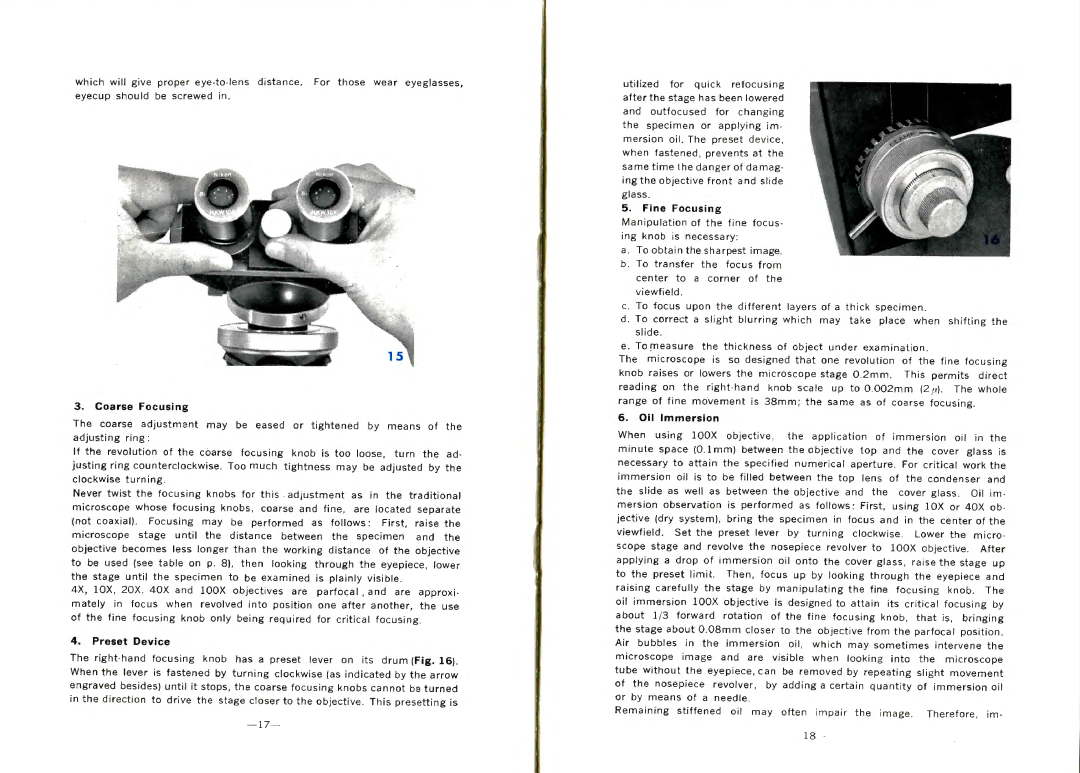
which will give proper
3. Coarse Focusing
The coarse adjustment may be eased or tightened by means of the adjusting ring:
If the revolution of the coarse focusing knob is too loose, turn the ad- justing ring counterclockwise. Too much tightness may be adjusted by the clockwise turning.
Never twist the focusing knobs for this adjustment as in the traditional microscope whose focusing knobs, coarse and fine, are located separate (not coaxial). Focusing may be performed as follows: First, raise the microscope stage until the distance between the specimen and the objective becomes less longer than the working distance of the objective to be used (see table on p. 8), then looking through the eyepiece, lower the stage until the specimen to be examined is plainly visible.
4X, lOX, 20X, 40X and lOOX objectives are parfocal , and are approxi- mately in focus when revolved into position one after another, the use of the fine focusing knob only being required for critical focusing.
4.Preset Device
The
— 1 7 - -
utilized for quick refocusing after the stage has been lowered and outfocused for changing the specimen or applying im- mersion oil. The preset device, when fastened, prevents at the same time the danger of damag- ingthe objective front and slide glass.
5.Fine Focusing
Manipulation of the fine focus- ing knob is necessary:
a.To obtain the sharpest image.
b.To transfer the focus from center to a corner of the viewfield.
c.To focus upon the different layers of a thick specimen.
d.To correct a slight blurring which may take place when shifting the slide.
e. Tomeasure the thickness of object under examination.
The microscope is so designed that one revolution of the fine focusing knob raises or lowers the microscope stage 0.2mm. This permits direct reading on the
6.Oil Immersion
When using lOOX objective, the application of immersion oil in the minute space (0.1mm) between the objective top and the cover glass is necessary to attain the specified numerical aperture. For critical work the immersion oil is to be filled between the top lens of the condenser and the slide as well as between the objective and the cover glass. Oil im- mersion observation is performed as follows: First, using lOX or 40X ob- jective (dry system), bring the specimen in focus and in the center of the viewfield. Set the preset lever by turning clockwise. Lower the micro- scope stage and revolve the nosepiece revolver to lOOX objective. After applying a drop of immersion oil onto the cover glass, raise the stage up to the preset limit. Then, focus up by looking through the eyepiece and raising carefully the stage by manipulating the fine focusing knob. The oil immersion lOOX objective is designed to attain its critical focusing by about 1/3 forward rotation of the fine focusing knob, that is, bringing the stage about 0.08mm closer to the objective from the parfocal position. Air bubbles in the immersion oil, which may sometimes intervene the microscope image and are visible when looking into the microscope tube without the eyepiece, can be removed by repeating slight movement of the nosepiece revolver, by adding a certain quantity of immersion oil or by means of a needle.
Remaining stiffened oil may often impair the image. Therefore, im-
18
